Wakatobi’s Ancient Reef Dwellers
Though sometimes overlooked by divers, sea sponges can be fascinating
Did you know that the reefs of Wakatobi are home to some of the oldest and most resilient creatures in the animal kingdom? Creatures that have survived more than a dozen planet-wide mass extinctions and outlasted the dinosaurs. You will find them everywhere from the shallows to the deepest dive sites, and they can live for hundreds of years. Sea sponges are pretty impressive for an animal that can’t even run away from danger.
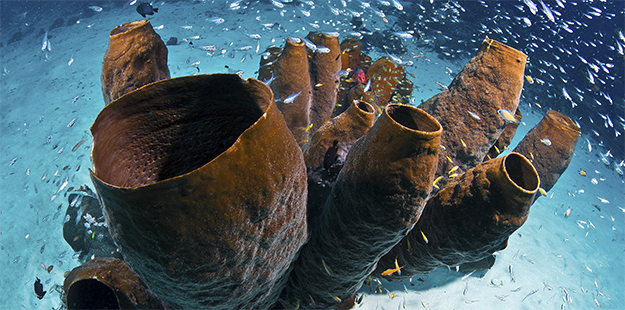
Fossil records indicate that sponges have been around for more than 750 million years and more than 5,000 known species thrive in the planet’s underwater ecosystems. Photo by Warren Baverstock
A growing understanding
Sponges were once thought to be plants. Which is understandable, because they have no brain, digestive system, or circulatory network. They stay rooted in place, grow like a colorful vegetable, and when chopped into small pieces, will anchor back to the reef and regenerate. But despite these plant-like qualities, scientists eventually determined that sponges are actually one of the planet’s simplest and oldest multi-cellular animals. And a closer look reveals a certain elegance to this seeming simplicity.
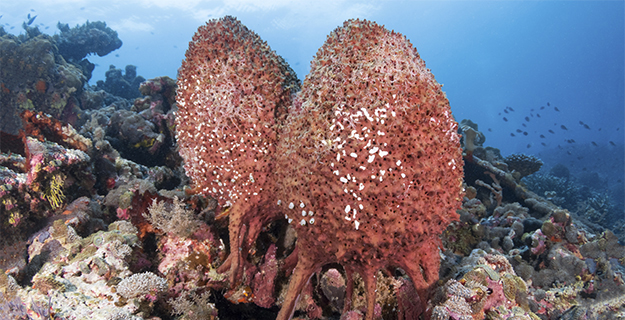
These sponges found at the dive site Zoo bring back memories of the Sci-fi movie, Alien. The pockmarks on the sponges’ surface are their mouths, or as a biologist would say, inhalant pores. Photo by Walt Stearns
Sponges are highly efficient filter feeders that don’t have to rely on currents to deliver their dinner, as they can generate their own water flow to draw in nutrients from the surrounding water. Studies have shown that sponges can draw in and filter up to 20,000 times their own volume of water in a 24-hour period.
The scientific classification for sponges is “Porifera,” which means “pore-bearing.” This refers to the numerous tiny round openings you will find on the surfaces of all sponges. These openings are lined with a unique type of cell known as choanocytes, which use tiny whip-like flagella to draw nutrient-laden water into and through a network of internal tunnels and canals. Sponges can regulate the flow of water by activating or resting individual flagella. Some varieties have also adapted to take advantage of currents, as they grow in shapes that create areas of low pressure around chimney-like openings, which helps draw wastewater out of the sponge.

Rigid skeleton-like silica structures, known as spicules, give a sponge its shape. Photo by Wayne MacWilliams
Another group of specially-adapted cells within a sponge will digest available nutrients from the water, including bacteria, plankton, and other organic particulates. Waste and water is then expelled back through a other network of tunnels and orifices. Holding all this together is a third type of cell that generates rigid skeleton-like silica structures known as spicules, which give the sponge its shape. Sponges are unique in the animal kingdom, because each of these different types of cells can transform and switch tasks when needed. This ability allows even a small fragment of a torn-apart sponge to re-establish itself with relative ease. Unlike corals, which have hard calcium-carbonate skeletons that build reefs, sponges will rapidly break down when they die, and become part of the bottom sediment.
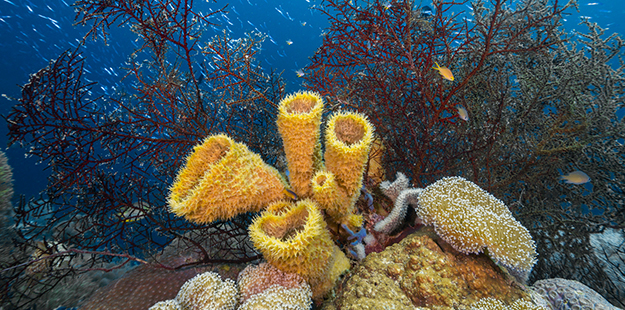
Even a small fragment of a torn-apart sponge can re-establish itself with relative ease. Photo by Marco Fierli, marcof8.com
Bath time favorites
Natural sea sponges are still harvested, but are no longer a household staple. The absorbent pads you buy as cleaning tools are most often synthetic, and made from cellulose wood fibers or foamed plastic polymers. Real sponges command higher prices, and are prized for their longevity, softness, absorbance and lack of odor. But don’t worry, the colorful varieties of sponges that adorn dive sites at Wakatobi are not threatened by humans. Of the 5,000 known species in the oceans, only a dozen are targeted for collection, and they live elsewhere.
Even when harvested, sponges typically thrive. Commercial sponge divers have learned to remove only the outermost portion of a sponge, which actually helps the animal regenerate and expand. In fact, studies have shown areas where sponges are harvested actually show an increase in the population. But should you be tempted to make your own bath sponges, we should mention that harvesting is not allowed on most reefs, including Wakatobi. In addition, soaking, curing and trimming sponges is an involved process. Simply pulling one from the water will not result in a product you’d want to use in the bathtub.
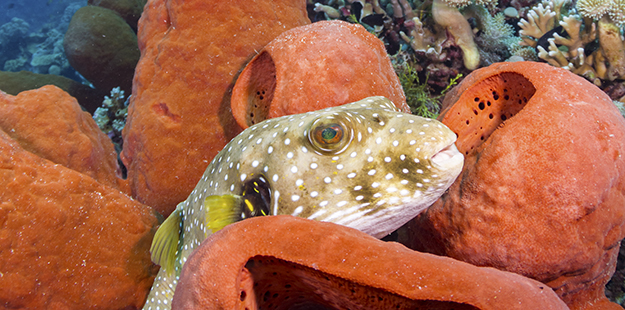
Certain reef dwellers such as turtles and pufferfish have built up an immunity to sponge toxins. Photo by Walt Stearns
On the menu
A sponge may not look like a tasty meal to divers, but there are a number of reef dwellers than will nosh on these living water filters. Wakatobi’s sea turtles are a primary culprit, and sea urchins, angelfish, filefish and some wrasses are also known to take a bite of sponge from time to time. Since they have no way to avoid being on the menu, sponges offset the disadvantages of immobility in one of two ways. About 70 percent of sponges on the reef use chemical warfare. They create toxic compounds that are unpalatable and in some case poisonous to would-be grazers. But even these defenses aren’t a sure thing, as turtles and certain other reef dwellers have built up an immunity to sponge toxins.
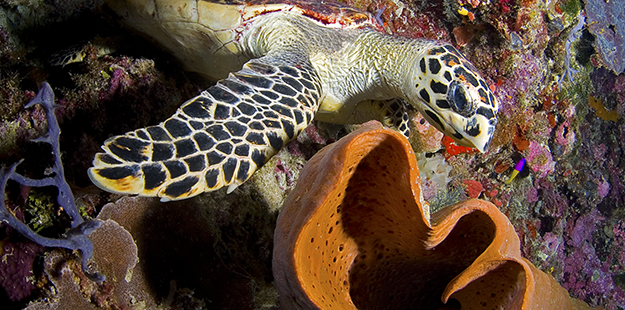
Even when torn to shreds by a hungry hawksbill, the sponge scraps left behind will soon reattach to the reef and go right back to growing and filtering. Photo by Wakatobi Resort
The chemically-defended varieties do fare much better at meal times than their undefended counterparts, which are subjected to the vast majority of feeding activity. To survive, these more tasty varieties rely on proliferation. They tend to grow much faster than the toxin-infused species, and can also heal more rapidly. Even when torn to shreds by a hungry hawksbill, the sponge scraps left behind will soon reattach to the reef and go right back to growing and filtering.
In addition to deterring predators, sponges may use chemical warfare to secure prime real estate on the reef. Many sponges will secrete compounds that discourage corals or other species of sponges from infringing on their territory. Scientists have found that some of these “stay off my lawn” compounds contain agents that could be used in pharmaceuticals treating certain types of cancerous tumors. Other sponge toxin derivatives may prove effective in treating diseases such as arthritis, heart disease and AIDS.
Making babies
Sponges are good at making more sponges, and they don’t necessarily need a partner to procreate. Most species can replicate asexually by budding. This results in the cluster-like formations common to some of the varieties of sponge you will find at Wakatobi. And even though they can’t get up off the reef and look for a date, some sponges are still able to make babies from eggs and sperm.
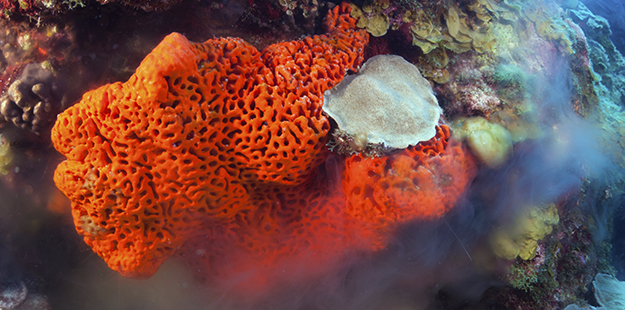
Sponges reproduce during certain phases of the moon, simultaneously releasing eggs and sperm into the water to increase the chances of fertilization. Photo by Walt Stearns
Much like corals, groups of sponges will coordinate the release of eggs and sperm into the water column, allowing the currents to bring things together for fertilization. The tiny larvae this produces will drift for a while then settle in to grow a new sponge colony.
Sponge central
The diversity of sponge life at Wakatobi is among the highest in the world, and the tally continues to grow. Marine biologists have recently discovered six new species in the waters of Sulawesi, bringing the region’s total sponge species count to more than 100. The vibrant, multi-hued reefs that this diverse bounty creates are a wide-angle photographer’s delight, and also provide critter spotters with a wealth of opportunities. Due to the sheer volume of marine life that thrives in Wakatobi, space and shelter are always at a premium. A wide variety of small fish and invertebrates may seek refuge in a sponge, and sometimes take up permanent residency.
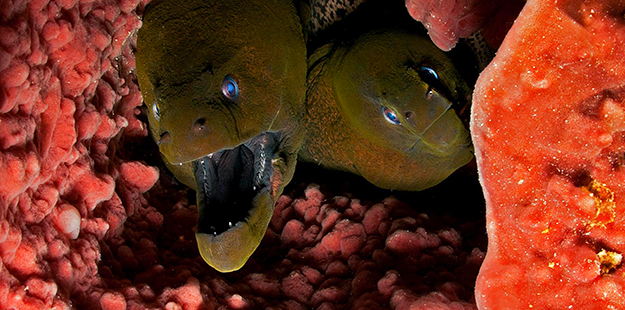
Don’t be surprised if a moray eel (or two) peeks out when you look inside one of Wakatobi’s big barrel sponges. Photo by Luc Eckhaut
A closer look at a cluster of tube sponges may reveal a group of tripplefin gobies hanging motionless and blending in, while a peek inside a barrel sponge could reward with a sighting of the delicate fuzz-covered purple limbs of a harry squat lobster. The larger sponges that grow in the middle and deeper depths of Wakatobi’s reefs may also hold larger surprises, as certain creatures that hunt at night may duck inside the inner cavity of a sponge during daylight hours. So don’t be surprised if you encounter the toothy grin of a moray eel when you peek inside one of Wakatobi’s big barrel sponges.
Sponges may not be the most exciting thing you will discover on the reefs of Wakatobi, but for those who take a closer look, these fascinating and ancient creatures can add an extra dimension to the diving and snorkeling experience. Something to keep in mind the next time you will be exploring one of the many world-class dive sites at Wakatobi Resort.
Contact us at office@wakatobi.com, or complete a quick trip inquiry at wakatobi.com.
Visit us on Facebook.


